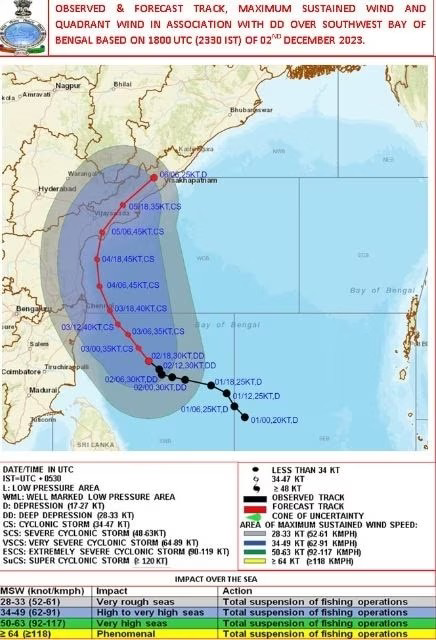
Cyclone michaung

05.12.2023
Cyclone michong , Daily Current Affairs , RACE IAS : Best IAS Coaching in Lucknow
|
For Prelims:About Cyclone Michong,Important points,About Cyclone For mains paper:Classification of cyclone,Naming of cyclones,Some guidelines countries should follow while choosing names for cyclones |
Why in the news?
Recently, the India Meteorological Department (IMD) has issued an alert due to the strengthening of cyclone 'Maichong' forming over the Bay of Bengal and South Andaman Sea.
Important points:
- According to reports, the cyclone may hit between Nellore and Machilipatnam in Andhra Pradesh and the north coast of Tamil Nadu.
- The India Meteorological Department (IMD) has issued an orange alert for several districts of Tamil Nadu as Cyclone Michong continues to loom over the Bay of Bengal and South Andaman Sea.
- IMD has issued 'Yellow Alert' as depression increases.
About Cyclone Michong:
- Cyclone Michong is the fourth cyclone in the Bay of Bengal and the sixth in the Indian Ocean this year.
- Cyclone Michaung was named “Michaung” at the suggestion of Myanmar.
- The word “Michong” means strength and flexibility.
About Cyclone:
- A cyclone is a pattern of winds (or air masses) that circulate around a low pressure system.
- It rotates counterclockwise in the Northern Hemisphere and clockwise in the Southern Hemisphere.
- It is usually associated with wet and stormy weather.
Classification of cyclone:
There are two types of cyclones.
tropical cyclone:
- It is an intense circular storm that originates from warm tropical oceans.
- It is characterized by low atmospheric pressure, strong winds and heavy rainfall.
- These are formed over slightly warm sea water.
- For a cyclone to form, the temperature of the upper layer of the ocean, to a depth of about 60 meters, must be at least 28°C.
- The periods April–May and October–December are favorable for cyclones.
- Then, low levels of air over the water require a 'counter-clockwise' rotation (in the Northern Hemisphere; clockwise in the Southern Hemisphere).
Extra tropical cyclone:
- These are also called temperate cyclones.
- It occurs in temperate regions and high latitude regions, although it has been known to originate in polar regions.
- They are active over the mid-latitude region between 35° and 65° latitude in both hemispheres.
- The direction of movement is from west to east and is more pronounced during the winter season.
Naming of cyclones:
- Tropical cyclones that form over different ocean basins are named by centers that are associated with the area of the cyclone in question such as Regional Specialized Meteorological Centers (RSMC) and Tropical Cyclone Warning Centers (TCWC).
- There are six regional centers across the world, including the India Meteorological Department's RMSC, and six TCWCs responsible for naming cyclones as well as issuing advisories.
- In tropical regions, a cyclone is named when it is determined to have attained cyclonic storm intensity, with wind speeds of 65 kilometers per hour (40 mph).
- These names have been selected from the new roster provided by the Regional Specialized Meteorological Center in New Delhi around mid-2020.
- If the tropical cyclone enters the basin from the western Pacific, it will keep its initial name.
The names of cyclones are proposed in alphabetical order and are used in that order.
- The names of the countries which are affected by the cyclones formed in the Arabian Sea and the Bay of Bengal are as follows - 1) Bangladesh, (2) India, (3) Iran, (4) Maldives, (5) Myanmar. , (6) Oman, (7) Pakistan, (8) Qatar, (9) Saudi Arabia, (10) Sri Lanka, (11) Thailand, (12) United Arab Emirates, (13) Yemen.
Some guidelines countries should follow while choosing names for cyclones:
- The proposed name should be neutral towards politics and political figures, religious beliefs, cultures and gender.
- The name should be chosen in such a way that it does not hurt the sentiments of any group of population across the world.
- Its nature should not be very rude and cruel.
- It should be short, easy to pronounce and should not be offensive to any member.
- The maximum length of the name will be eight characters.
- The proposed name should be provided with its pronunciation and voiceover.
Names of tropical cyclones over the northern Indian Ocean will not be repeated. Once used, it will not be reused again.